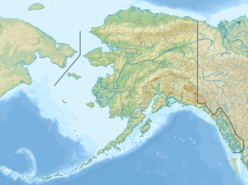Augustine Volcano
| Augustine Volcano | |
|---|---|
 | |
| Highest point | |
| Elevation | 4,134 ft (1,260 m) [1] |
| Prominence | 1,260 metres (4,130 ft) |
| Listing | List of volcanoes in the United States |
| Coordinates | 59°21′48″N 153°26′00″W / 59.36333°N 153.43333°W / 59.36333; -153.43333Coordinates: 59°21′48″N 153°26′00″W / 59.36333°N 153.43333°W / 59.36333; -153.43333 [2] |
| Geography | |
 Augustine Volcano Cook Inlet, Alaska, U.S. | |
| Topo map | USGS Iliamna B-2 |
| Geology | |
| Age of rock | more than 40,000 years[2] |
| Mountain type | Lava domes[2] |
| Volcanic arc | Aleutian Arc |
| Last eruption | 2005 to 2006[2] |
Augustine Volcano is a central lava dome and lava flow complex, surrounded by pyroclastic debris.[3] It forms Augustine Island in southwestern Cook Inlet in the Kenai Peninsula Borough of southcentral coastal Alaska, 174 miles (280 km) southwest of Anchorage. Augustine Island has a land area of 32.4 square miles (83.9 km2), while West Island, just off Augustine's western shores, has 2 sq mi (5.2 km2).
The island is made up mainly of past eruption deposits. Scientists have been able to discern that past dome collapse has resulted in large avalanches.
Contents
1 Description and geologic history
2 Eruptive activity
2.1 2006
3 Sensor Networks
4 See also
5 References
6 External links
Description and geologic history
The nearly circular uninhabited island formed by Augustine Volcano is 12 km (7.5 mi) wide east-west, 10 km (6 mi) north-south; a nearly symmetrical central summit peaks at altitude 4,134 feet (1,260 m).

USGS map of Augustine Volcano island
Augustine's summit consists of several overlapping lava dome complexes formed during many historic and prehistoric eruptions. Most of the fragmental debris exposed along its slopes comprises angular blocks of dome-rock andesite, typically of cobble to boulder size but carrying clasts as large as 4 to 8 meters (10 to 25 feet), rarely as large as 30 meters (100 ft). The surface of such deposits is skeet, a field of steep conical mounds and intervening depressions with many meters of local relief. En route to Katmai in 1913, Robert F. Griggs had briefly inferred landslide (debris avalanche) as the origin of Augustine's hummocky coastal topography about Burr Point, by geomorphic analogy with the hummocky and blocky deposit of a 1912 landslide near Katmai.
The hummocky deposits on Augustine's lower flanks resemble both topographically and lithologically those of the great landslide or debris avalanche that initiated the spectacular May 18, 1980 eruption of Mount St. Helens. The deposit of that landslide revealed the origin of coarse diamicts with hummocky topography at other strato volcanic cones. Since 1980 many hummocky coarsely fragmental deposits on Augustine's lower flanks have come to be interpreted as deposits of numerous great landslides and debris avalanches.
Eruptive activity

Thermal image after the January 2006 eruptions. White parts of the image are warmer than dark areas.
A March 27, 1986 eruption deposited ash over Anchorage and disrupted air traffic in southcentral Alaska.
On January 11, 1994, Augustine erupted at 13:44 and 14:13 UTC.
2006
In mid-December 2005 a sulfur dioxide-laden plume of steam, hundreds of small earthquakes and a new coating of ash over its currently snow-clad peak, taken together, suggested that Augustine was building to a new eruption, likely in 2006.[4] The eruption consisted of four "phases", continuing from December to March 2006.
The initial stage of the eruption began when microearthquake activity increased steadily from May to December 2005. At first, they started out at around 2 each day to around 15 each day. Microearthquakes are tiny earthquake that suggest a volcanic eruption could possibly occur.[5]

2006 eruption
The volcano erupted on January 11, 2006, entering a second "stage", which would continue until January 28. Tectonic earthquakes began early in January, resulting in an explosive Volcanic Explosivity Index 3 eruption later in that day. Several ash columns were generated, each 9 km (6 mi) above sea level; these plumes were steadily influenced to the north and northeast of the volcano. Samples of the tephra were dense, insinuating that the lava released was mature.[5]
Six explosions were recorded by seismic instruments between January 13, the first of these consuming a seismograph and a CPGS located on the northwestern flank. Ash columns now reached 14 km (9 mi) and Kenai Peninsula residents reported ash deposits. On January 16, a new lava dome was observed on the summit; and the next day another explosive eruption sent ash 13 km (8 mi) into the atmosphere. This explosion created a 20-30 meter wide crater in the new lava dome.[5]
On September 22, 2007, the Alaska Volcano Observatory reported that shallow earthquake activity had increased over the week of September 22. However, the activity was less than its level during the months leading up to the 2005-2006 eruption.
Sensor Networks
The Plate Boundary Observatory, operated by UNAVCO has a network of 10 high-precision GPS instruments on the flanks of Augustine. Activity two years ago claimed two of these sites. The Alaska Volcano Observatory also operates a number of seismometers and tiltmeters all around the volcano, including four webcams.
See also
- List of volcanoes in the United States
References
^
"Augustine Description and Statistics". Alaska Volcano Observatory. United States Geological Survey. Archived from the original on 14 January 2009. Retrieved 2009-01-19.
^ abcd "Augustine". Global Volcanism Program. Smithsonian Institution. Retrieved 2009-01-19.
^ Augustine Volcano description and information, United States Geological Survey Alaska Volcano Observatory. Retrieved 2014-02-13.
^ http://www.cnn.com/2005/TEC/science/12/15/augustine.volcano.ap/index.html. Retrieved May 24, 2011. Missing or empty|title=(help)[dead link]
^ abc
"Event Specific Information: Augustine - 2005". Alaska Volcano Observatory. United States Geological Survey. Retrieved February 3, 2008.
External links
- Augustine activity
- Augustine Volcano Live Webcam
- NASA Images from December 2005

 Clash Royale CLAN TAG#URR8PPP
Clash Royale CLAN TAG#URR8PPP